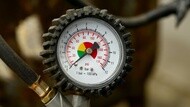
Tips and advice motorbike
Your tyres are the only part of the vehicle in contact with the road looking after them is an essential part of Motorbike. Regular maintenance doesn’t only allow you to maximise tyre life, but also performance.
So, what’s the most effective way to maintain your motorbike tyres? Allow our experts to explain.
Benefits of maintaining your motorbike tyres
Maintaining tyre performance
Your tyres are essential for your safety. You need to maintain them so that they continue to offer the same performance.
Maximising tyre life
Avoid unnecessary costs linked to replacing your tyres prematurely, good tyre maintenance allows you to maximise tyre life right to the last mile.
Motorbike tyre pressure is key to tyre longevity and safety
To maintain optimal performance until the end of a tyre’s life, motorbike tyre pressure is key. That’s why it’s important to check tyre pressure regularly and to adjust if necessary. Riding with incorrect pressure can lead to increased wear, which can compromise on performance and therefore your safety, while also reducing tyre life.

Motorbike tyre pressure is also important
We recommend that you check your tyre pressure once a month and before every long journey, ideally when the tyres are cold (before riding or having ridden less than 2 miles). If you have to check tyre pressure when the tyres are hot, you should add 0.3 bar to the pressure recommended by the manufacturer. For example, if the recommended pressure when cold is 2.5 bar, you should set hot tyres to 2.8 bar. If the tyres don’t have enough pressure, set them to 2.8 bar. If, on the other hand, your tyres are above 2.8 bar, you should not take any out. In either scenarios, we recommend you quickly re-check your cold pressures.
At the same time, check that the tyres still have their valve caps. If a valve cap is missing, you should replace it immediately as it’s important for keeping the tyre airtight.
What’s the right motorbike tyre pressure?

The guidelines to follow are those recommended by the manufacturer (which can be found in your motorbike’s user manual), although there are some exceptions for motorbike tyre pressure:
- For Trail use, when you might be riding off-road as much as on it, you may need to make motorbike tyre pressure adjustments depending on the surface: you may want to lower tyre pressure for better grip during all-terrain rides, but it's vital that your tyres are reset to the approved pressure when you get back on the road.
- For track use with road legal tyres, you can choose between two different pressures. Remember, if you're travelling to your motorbike track day experience via road, make sure to readjust to the manufacturer-recommended tyre pressure before you set off again.
- When using only on the track, the tyre manufacturer, independently of the motorbike manufacturer, is the one who recommends the tyre pressure to use for optimal performance.
For more information, see our motorbike tyre pressure guide.
Checking tyres
Checking general tyre condition
While adjusting your motorbike tyre pressure, take the opportunity to check their general condition, making sure specifically:
- that they aren’t damaged (bulges, tears, etc.),
- that they haven’t been punctured by a nail or screw.
If you find one or more of these anomalies, we recommend that you visit a professional. For more information, read our article "Is my tyre repairable?"
Checking wear
Wear is inevitable for any tyre. By setting tyres to the recommended pressure, you will maximise tyre life: regular, normal wear will allow you to ride without compromising tyre performance until they reach the wear threshold, when they need to be replaced.
When checking tyres, make sure:
- that there is no abnormal or irregular wear on the tyres,
- that the wear indicators have not reached the limit.
If there is any abnormal or irregular wear, seek professional assistance to get a qualified opinion on the condition of your tyres.
If there is severe wear (wear indicators have reached their limit for road and/or track legal tyres, or performance is reduced for other uses), you’ll need to replace your tyre.
Note that a uniform front/rear fitting is recommended, which would mean replacing both tyres. If replacing just one tyre, we advise that you choose one from the same range. In any scenario, whether replacing one or two tyres, always respect sizes as well as the load and speed ratings approved by the manufacturer.
Checking balance weights
Wheel balancing is done when tyres are fitted. When a professional fits your motorcycle with one or two tyres, they may have to place weights on your wheels to ensure vibration-free riding.
Inspecting tyres is also the time to check that the balance weights are still in place. If they are not, contact a professional so that they can rebalance them.
Cleaning tyres
You can clean your tyres when you wash your motorbike.
We advise against ever using solvent-based products (petrol, acetone, etc.) or tyre polish. A simple wash with soap and water is the best option for cleaning your tyres without damaging them.
If you’re using a pressure washer, do not get too close to the tyres.
Storing your motorbike for a long period of time

You may not need to use your motorbike for a relatively long time, such as over winter. If this is the case, your tyres will remain stationary all that time while supporting the weight of your motorbike. These few precautions will help maximise tyre life.
If your motorbike has a centre stand, use it to keep your back tyre off the ground.
As a general rule, we recommend setting your tyres to the right pressure before storing them for a long period of time. Since tyres naturally lose air over time, inflating them before storing them for winter (to the recommended pressure, or even a bit higher) helps prevent the tyres from deforming under the weight of the bike.
If possible, regularly moving your motorcycle can act as an extra precaution to preserve your tyres. This helps prevent it always being the same part of the tyre that’s touching the ground.

FIND A MICHELIN TYRE DEALER NEAR YOU IN SECONDS
Search by
Address, City or Postcode
Locate me

